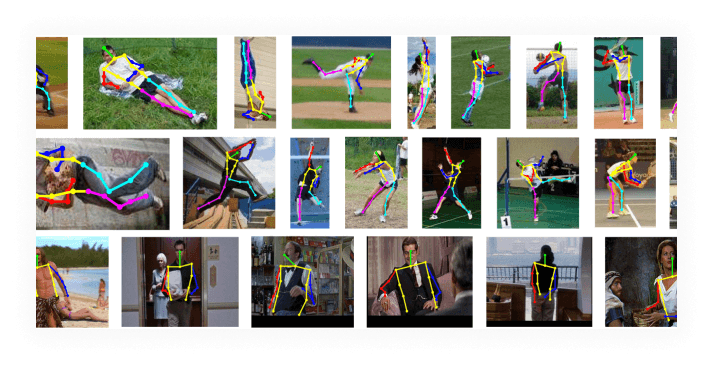Pose estimation is a computer vision technique that involves predicting the position and orientation of a person or object in an image or video. This process involves the identification and tracking of key points, which may correspond to various joints in the human body or specific parts of an object. Pose estimation is a critical component in a range of applications, including human-computer interaction, sports analytics, animation, and autonomous driving, where understanding the spatial arrangement of subjects is necessary for effective interaction and decision-making.

Understanding Pose Estimation
Definition
Pose estimation is the process of determining the pose of a person or object by analyzing visual data to estimate the location and orientation of key points. These key points might include body joints like elbows, knees, and ankles for humans, or distinctive features such as edges or corners for objects. The task can be performed in two-dimensional (2D) or three-dimensional (3D) space, depending on the requirements of the application.
Variations of Pose Estimation
- Human Pose Estimation: Focuses on detecting human body joints and key points to understand human posture and movement.
- Object Pose Estimation: Involves identifying specific parts of an object, such as the wheels of a car or the handle of a cup.
- Animal Pose Estimation: Adapted for detecting key points in animals for behavioral studies or veterinary applications.
How Pose Estimation Works
Pose estimation is typically achieved using deep learning techniques, specifically convolutional neural networks (CNNs), which process images to detect and track key points. The process can be categorized into two primary approaches: bottom-up and top-down methods.
- Bottom-up Methods: These methods detect all possible key points in the image first and then group them to form a coherent pose for each subject. Notably, methods like OpenPose and DeepCut utilize this technique, allowing for accurate detection even in crowded scenes.
- Top-down Methods: These begin by identifying the subject in the image, usually with a bounding box, and then estimate the pose within this region. PoseNet and HRNet are popular models that employ this approach, offering high-resolution outputs suitable for detailed pose detection.
2D vs. 3D Pose Estimation
- 2D Pose Estimation: Involves estimating the spatial location of key points in a 2D plane. This is computationally less intensive and well-suited for applications like video monitoring and simple gesture recognition.
- 3D Pose Estimation: Provides a three-dimensional representation, adding depth (Z-axis) to the key points. This is crucial for applications requiring detailed spatial orientation, such as virtual reality and advanced robotics. Cutting-edge models like BlazePose are enhancing capabilities in this domain, providing up to 33 key points for precise motion tracking.
Pose Estimation Models
Various models and frameworks have been developed to facilitate pose estimation, leveraging different machine learning and computer vision techniques.
Popular Models
- OpenPose: A widely used framework for real-time multi-person pose estimation. It can detect body, hand, and facial key points. OpenPose is renowned for its ability to handle multiple people in a single frame effectively.
- PoseNet: A lightweight model suitable for mobile and web applications, capable of performing real-time pose estimation. Its integration with TensorFlow makes it highly adaptable for various platforms.
- HRNet: Known for maintaining high-resolution representations, suitable for detecting subtle key point variations. This model excels in providing detailed and accurate outputs necessary for professional applications.
- DeepCut/DeeperCut: These models are designed for multi-person pose estimation, addressing the challenges of occlusion and complex scenes. They are particularly effective in scenarios where multiple subjects interact closely.
Applications of Pose Estimation
Fitness and Health
Pose estimation is increasingly used in fitness applications to provide real-time feedback on exercise form, reducing the risk of injury and enhancing the effectiveness of workouts. It is also used in physical therapy to assist patients in performing exercises correctly through virtual coaching.
Autonomous Vehicles
In the realm of autonomous driving, pose estimation is used to predict pedestrian movements, enhancing the vehicle’s ability to make informed navigation decisions. By understanding the body language and motion patterns of pedestrians, autonomous systems can improve safety and traffic flow.
Entertainment and Gaming
Pose estimation enables interactive and immersive experiences in gaming and film production. It allows for the seamless integration of real-world movements into digital environments, enhancing user engagement and realism.
Robotics
In robotics, pose estimation facilitates the control and manipulation of objects. With accurate pose data, robots can perform tasks such as assembly, packaging, and navigation with higher efficiency and precision.
Security and Surveillance
Pose estimation enhances surveillance systems by enabling the detection of suspicious activities based on body movements. It allows for real-time monitoring of crowded areas, assisting in the prevention and response to incidents.
Challenges in Pose Estimation
The task of pose estimation comes with several challenges, including:
- Occlusion: When parts of the subject are obscured by other objects, making it difficult to detect all key points.
- Variability in Appearance: Differences in clothing, lighting, and background can affect the accuracy of pose estimation models.
- Real-Time Processing: Achieving high accuracy in real-time applications requires significant computational resources and efficient algorithms. However, advancements in hardware and efficient algorithms are steadily overcoming these barriers.
Research
Pose estimation is a critical task in computer vision that involves detecting the configuration of human or object poses from visual inputs, such as images or video sequences. This field has gained significant attention due to its applications in human-computer interaction, animation, and robotics. Below are some key research papers that provide insights into pose estimation advancements:
- Semi- and Weakly-supervised Human Pose Estimation
Authors: Norimichi Ukita, Yusuke Uematsu
This paper explores three semi- and weakly-supervised learning schemes for human pose estimation in still images. It addresses the limitations of relying solely on supervised training data by introducing methods that leverage unannotated images. The authors propose a technique where a conventional model detects candidate poses, and a classifier selects true-positive poses using pose features. These methods are enhanced by action labels in semi- and weakly-supervised learning schemes. Validation on large-scale datasets demonstrates the effectiveness of these approaches. Read more. - PoseTrans: A Simple Yet Effective Pose Transformation Augmentation for Human Pose Estimation
Authors: Wentao Jiang, Sheng Jin, Wentao Liu, Chen Qian, Ping Luo, Si Liu
Addressing the challenge of long-tailed distribution in pose datasets, this paper introduces Pose Transformation (PoseTrans) as a data augmentation method. PoseTrans generates diverse poses using a Pose Transformation Module and ensures plausibility with a pose discriminator. The Pose Clustering Module helps balance the dataset by measuring pose rarity. This method improves generalization, especially for rare poses, and can be integrated into existing pose estimation models. Read more. - End-to-End Probabilistic Geometry-Guided Regression for 6DoF Object Pose Estimation
Authors: Thomas Pöllabauer, Jiayin Li, Volker Knauthe, Sarah Berkei, Arjan Kuijper
This paper focuses on 6D object pose estimation, crucial for XR applications, by predicting an object’s position and orientation. The authors reformulate a state-of-the-art algorithm to estimate a probability density distribution of poses instead of a single prediction. By testing on core datasets from the BOP Challenge, the paper showcases enhancements in pose estimation accuracy and the generation of plausible alternative poses. Read more.


